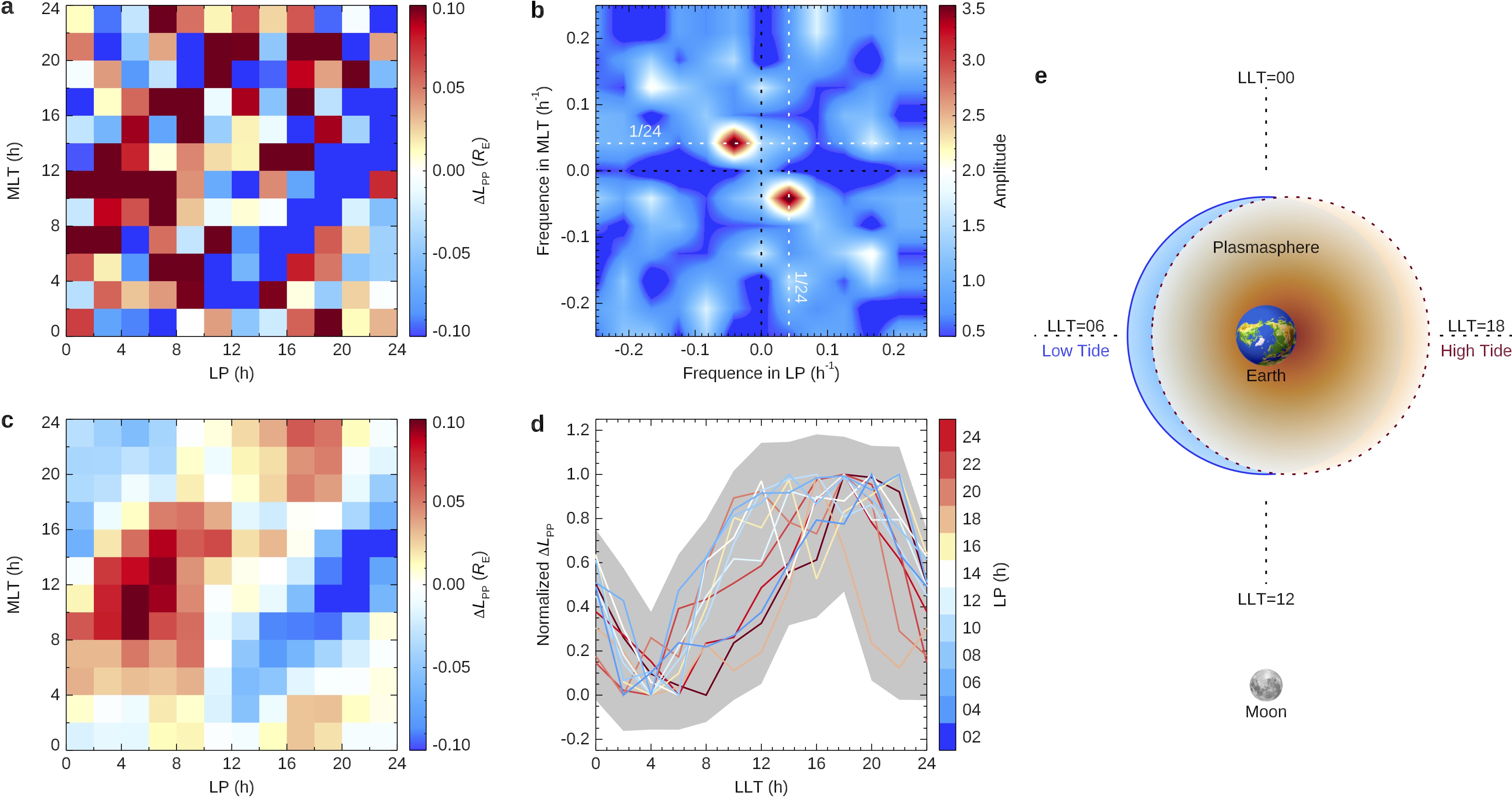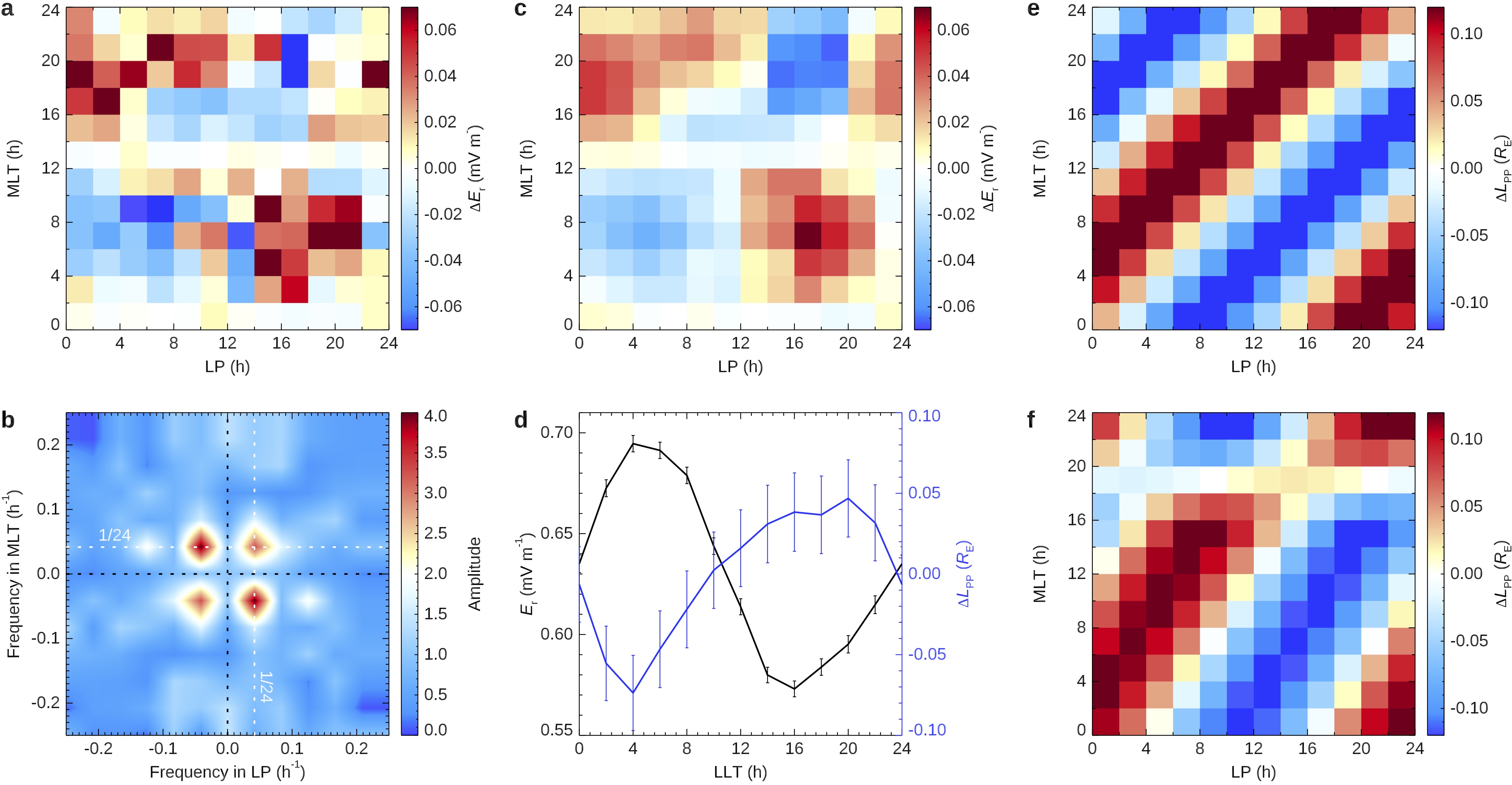
2023 THEMIS SCIENCE NUGGETS
Evidence for lunar tide effects in Earth’s plasmasphere
Chao Xiao and Quanqi Shi
Institute of Space Sciences, Shandong University
Introduction
Tides are universal phenomena and often play essential roles in planetary and galactic systems wherever gradients in gravitational attraction are important. As the Earth’s sole natural satellite, the Moon and its gravitational interaction with Earth have attracted extensive research and curiosity over several hundred years. Periodic lunar tides have since been well-known to affect the first three states of matter in the Earth-Moon system: solid Earth tides, liquid ocean tides, and neutral gas-dominated atmospheric tides, which are common in all planetary-moon systems. These lunar tides mainly have semidiurnal (and semimonthly) periods and are of fundamental importance to conditions on our planet. If we follow the four states of matter, they progress from solid, liquid and gas to plasma, which is the dominant component of the Earth–Moon space environment. In the past, lunar tides were mainly found to affect the first three states: solid Earth tides, liquid ocean tides and neutral gas-dominated atmospheric tides. Whether lunar tides can influence the plasma-dominated regions, which are much more extensive in space, has not yet been explored. The Earth's plasmasphere is the most ideal and representative plasma-dominated place to study the existence of lunar tides in plasma, because its basic properties have been studied extensively and there are massive amounts of observational data. The plasmasphere is a collisionless magnetized plasma region that extends along geomagnetic field lines from the upper ionosphere (its source region), filling a roughly torus-shaped volume in near-Earth space. It is composed of cold (1-2 eV) and dense (102-104 cm-3) plasma with quasi-equal numbers of electrons and ions (~80% H+, ~10–20% He+ and ~5–10% O+), and plays a key role in particle exchange and storage within the magnetosphere. Given its cold, dense plasma properties, the plasmasphere can be regarded as a “plasma ocean”, and the plasmapause represents the “surface” of this ocean because of the dramatic change of plasma properties across this boundary. Hence, in order to explore the existence of a lunar tidal effect in this cold plasma ocean, it is natural to examine whether these “sea surface” variations may be associated with the lunar cycle. In this study, a large database of plasmapause positions determined by 50,778 plasmapause crossings from THEMIS (12,770) and other missions is used.
Results
Using this database, we report the first identification of lunar tides on the surface of this plasma ocean, as shown in Figure 1. Regarding the characteristics of the lunar plasmaspheric tide, we found that this signal possesses distinct diurnal (and monthly) periodicities, surprisingly different from the semidiurnal (and semimonthly) variations dominant in the atmosphere, ocean, and solid Earth tides. Interestingly, the lunar plasmaspheric tide forms a plasmasphere bulge that is offset 90 degrees ahead of the Earth-Moon axis, which is significantly different from the ocean high tide as illustrated in Figure 2. In order to rule out the possibility of data anomalies and ensure the reliability of the results, the database was divided into two sub-datasets analyzed in three different ways. In all cases, similar and consistent tidal signals were observed.
| Figure 1. The variation of ∆LPP binned in 2 h windows in both magnetic local time (MLT) and lunar phase (LP), where ∆LPP is plasmapause perturbation data and its unit is RE (Earth’s radius, 1 RE = 6371 km). b, The two-dimensional Discrete Fourier Transform amplitude of ∆LPP in panel a. The two red spots represent frequencies with the highest amplitude in MLT and LP, respectively. The black and white dashed lines indicate frequencies equal to 0 and 1/24 for reference, respectively. c, The variation of ∆LPP binned in 6 h windows in both MLT and LP. d, Variations of the normalization of c as a function of lunar local time (LLT) at different LPs. The LLT is defined as (12-LP+MLT) mod 24 with LLT=12 corresponding to lunar noon. The grey shaded band represents the normalized 95% confidence interval error, which is defined here as the 95% confidence interval error divided by the difference between the maximum and the minimum of ∆LPP. e, Illustration of Lunar Tidal Wave in the Plasmapause (LTWP) in the LLT frame in the Earth-Moon space. The background plasmapause is shown by the blue circle. The modulation of the plasmapause by lunar tide is shown by the red dashed circle, left for low tide and right for high tide. |
| Figure 2. Comparison of the ocean tide (blue) and the lunar plasmaspheric tide (orange). |
After confirming that this lunar signal exists, the essential question is how does such a lunar tide with such an offset and diurnal/monthly periods occur in the plasmasphere? It is known that the motion of the low energy charged particles and the electric field are essential in determining the position of plasmapause. The electric field in the inner magnetosphere is composed of the steady corotation electric field that is determined by Earth’s magnetic moment and rate of rotation, and the varying magnetospheric convection electric field that is controlled by solar wind and geomagnetic activity. Thus, we used independent observations from NASA Van Allen Probes observations to check the electric field and found observational evidence for the existence of lunar tidal variations in the distribution of the radial electric field, as shown in Figure 3. The periodicity of this lunar tidal signal in the radial electric field is also diurnal and monthly, which is like that of the lunar tide wave in the plasmapause but with a phase difference of 180º. Using two plasmapause formation models (“Zero Parallel Force surface” and “Last Closed Equipotential”), we showed that the perturbed electric field is capable of generating the observed lunar tide in the plasmapause.
| Figure 3. Independent electric field observation and cold plasma convection modelling. a, The perturbations (∆Er) of the radial component of the electric field Er (positive Er towards the Earth in this study) measured by the Van Allen Probes binned in 2 h windows in both magnetic local time (MLT) and lunar phase (LP). b, The two-dimensional Discrete Fourier Transform amplitude of ∆Er in panel a. The black and white dashed lines indicate frequencies equal to 0 and 1/24 for reference, respectively. c, The perturbations of ∆Er binned in 6 h windows in both MLT and LP. d, Variations of Er (black) and ∆LPP (blue) with lunar local time (LLT), where ∆LPP is plasmapause perturbation data in unit of RE (Earth’s radius, 1 RE = 6371 km). The vertical error bars in panel d denote the 95% confidence intervals. e-f, Perturbations of the plasmapause derived from the two plasmapause formation models, Zero Parallel Force surface (ZPF) and last closed equipotential (LCE), respectively. |
Conclusion
We have explored in this work the existence of a lunar plasma tidal effect in Earth-Moon space. By analyzing an extensive database containing an unprecedented quantity of plasmapause location observations, we found that a lunar tide signal exists in the plasmasphere with diurnal (and monthly) periodicities. This plasma tide contrasts with the lunar tides in lower altitude regions for the first three states of matter, which have semidiurnal (and semimonthly) periodicities. The high tide occurs at LLT = 18 h while the low tide occurs at LLT = 6 h. Van Allen Probes observations of the radial electric field near the equatorial plane are shown to exhibit modulations synchronized with lunar phase. Using two plasmapause formation models, we show that this modulation provides the capability of generating the observed plasmaspheric lunar tidal signals. This result further advances our understanding of the Moon-atmosphere-magnetosphere coupling process through gravitation, with important participation of the electromagnetic force.
Reference
Xiao, C., He, F., Shi, Q. Q., Liu, W. L., Tian, A. M., Guo, R. L., Yue, C., Zhou, X. Z., Wei, Y., Rae, I. J., Degeling, A. W., Angelopoulos, V., Masongsong, E. W., Liu, J., Zong, Q. G., Fu, S. Y., Pu, Z. Y., Zhang, X. X., Wang, T. Y., Wang, H. Z., Zhang, Z.: Evidence for lunar tide effects in Earth’s plasmasphere, Nature Physics, 2023Biographical Note
Dr. Chao Xiao is a postdoctoral fellow in Institute of Space Sciences, Shandong University. His research focuses on the Earth-Moon space environment and Earth’s cusp region.
Professor Quanqi Shi is leading an international research group on solar wind-magnetosphere interactions in Institute of Space Sciences, Shandong University. His research widely covers solar wind-magnetosphere-Moon interaction, Earth-Moon space environment, aurora in the Earth and other planets, planetary space environment and beyond.
Wenlong Liu is a professor at the School of Space and Environment, Beihang University. His research focuses on dynamics in the inner magnetosphere and space weather.
Fei He is a professor at Key Laboratory of Earth and Planetary Physics, Institute of Geology and Geophysics, Chinese Academy of Sciences. His research focuses on characterizing global dynamics in Earth's and planetary space environments using optical imaging in combination with in-situ measurements.
 Please send comments/suggestions to
Emmanuel Masongsong / emasongsong @ igpp.ucla.edu
Please send comments/suggestions to
Emmanuel Masongsong / emasongsong @ igpp.ucla.edu



